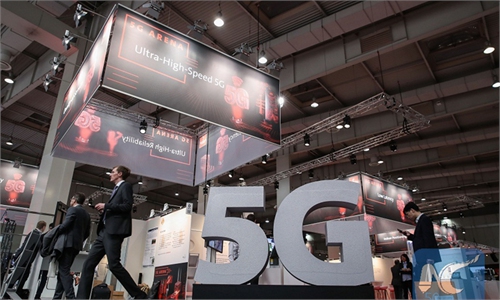SOURCE / INDUSTRIES
China to build 600k 5G base stations in 2020: official

A red telephone booth on Middle Huaihai Road in downtown Shanghai has been transformed into a 5G mini base station. Near the station, the 5G network speed is stable at around 800Mbps – 10 to 20 times the speed of the 4G network. Photo: cnsphoto
China is expected to build more than 600,000 5G base stations by the end of the year, and the shipment of 5G smartphones will reach 180 million units, said an official with the country's top information technology watchdog on Saturday.
As 5G are going mainstream in China, the country embarks on a 10-year long march of developing 6G technologies. But industry analysts said China needs to overcome its shortcomings in chip and operating systems in order to take the lead in next-generation information technology.
Saturday marks the 1st anniversary of 5G commercialization in China. Over the past year, China has built over 250,000 5G bases and the number of 5G users exceeded 36 million, Lu Chuncong, an official with the Ministry of Industry and Information Technology, said at an online conference on Saturday.
"The progress in 5G research and development (R&D), user numbers and base construction is remarkable, as China's 5G network application currently leads the world," Fu Liang, a Beijing-based telecom industry expert, told the Global Times on Saturday. He said the country lagged behind global front-runners nine years in the 3G era and four years in the 4G era.
According to Lu, the number of China's 5G bases is expected to exceed 600,000 by the end of this year and the shipment of 5G smartphones will reach 180 million units. Meanwhile, over 600 "5G plus industrial internet" projects covering industries including transportation and healthcare are in process.
Sun Yanbiao, head of Shenzhen-based research firm N1mobile, told the Global Times on Saturday that Huawei accounts for about 60 percent of domestic 5G base station market thanks to its advantages in self-developed technologies.
Across the world, Huawei announced in early February that it had obtained 91 commercial contracts on 5G, of which over half came from Europe.
While pushing forward 5G commercialization, Huawei has made progress in 6G pre-research. "With the judgment that 6G will use a millimeter wave, Huawei is now at the stage of exploring using scenarios and technologies," Yang Tao, vice president of Huawei's China carrier business unit, said in a recent interview with domestic news site tech.sina.cn.
Yang said relevant 6G applications are expected to emerge around the year 2030.
Industry analysts gave a tentative roadmap toward the technology's commercialization in 2030: come up with a vision of 6G by around 2023, standardize technological specifications by 2026 and roll out technologies by 2028.
Tapping into the expertise of Huawei and other mobile phone and electronic parts markets, there is hope for China to maintain its lead in the 6G era, but it needs to make breakthroughs in key technologies to shield its tech sector from cracking down by countries such as the US, according to analysts.
Fu said that the 6G network will introduce much more advanced technologies, for example, high-end chips for high-speed data processing and more base stations for shorter wavelength.
"There is a gap between China and other tech powers in chip design, operating systems and testing," Fu said, noting that he is confident that China is able to make breakthroughs in these aspects as Huawei has ramped up efforts to replace foreign-made components despite the US' unreasonable crackdown.



